Dimanche in Paris in Autumn:
The words of that quintessential song about Paris spring to mind and I hum “I love 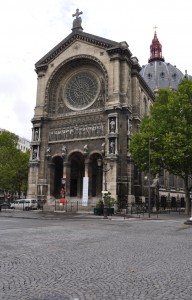 Paris in the fall….when it drizzles’’ which is the weather as I slip inside Sunday morning mass at imposing, historic l’Eglise, St Augustin’s Catholic Church.
Paris in the fall….when it drizzles’’ which is the weather as I slip inside Sunday morning mass at imposing, historic l’Eglise, St Augustin’s Catholic Church.
It is an awesome structure dominating Place St Augustin at the terminus of six roads and I have admired it from our front suite of the Cercle National des Armees across the road for the last two days. I have wondered if it is an empty shell.
Yesterday evening, we sat a la terrace at the typically Parisian Café Conti at another intersection of five roads on the Left Bank, where a perpetual traffic jam of noisy cars, roaring motor cycles and buses edged their way into and out of Rue de l’Ancienne Comedie. Then sirens of police cars whined, and the cacophony seriously questioned the quintessential image of Paris as the city of romance.
Rue de Buc, where we positioned ourselves was a conveyor belt of pedestrians, stylish young things, teens in jeans, mothers and fathers pushing prams, grandmothers grasping children, tourists galore and smart men in twosomes. A couple of Aussie blokes grab a table next to us. And a file of tourists pushing bicycles stop, park their bikes and walk down the side-street.
Another pop song by Blue Mink sprang to mind, the one about “coffee coloured people by the score’’ as I observed this intriguing melting pot of people passing by – white, black and many shades of pale, the products of myriad nationalities. We strung out our beers for an hour until 6.30pm and then we moved on to Le Bar a Huitres, one of three famous restaurants which hug the corners of Boulevard Montparnasse and Rue Raspail. We bypassed the other more famous eateries – Le Dome, where Modigliani reputedly would paint in the glass dome atop the five-story building and La Rotande where people had snapped up every pavement table. They became the catalyst for writers, poets and artists who congregated in the cafes.
We sat, instead, across the road at a prized window table alongside a bus stop around the corner and ate a dozen delicious, plump No. 2 oysters f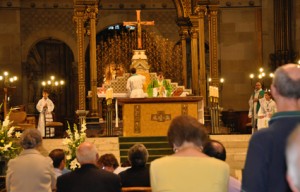 ollowed by swordfish, sploshed down by a French Sancerre blanc vin and, of course, coffee.
ollowed by swordfish, sploshed down by a French Sancerre blanc vin and, of course, coffee.
After such an exciting evening, a quiet Sunday church service seems balm for the soul and I sit quietly in historic St Augustin and soak up the organ music, the incense, the choir singing and the majesty of high mass conducted since 1860 in this place.
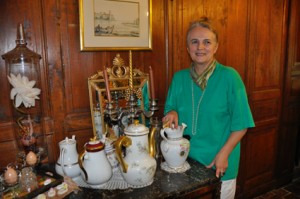 The ghost of the Domaine de la Dame de la Lauriere would have enjoyed this evening’s soiree around the dining room table in the house she once inhabited.
The ghost of the Domaine de la Dame de la Lauriere would have enjoyed this evening’s soiree around the dining room table in the house she once inhabited. n of a certain age and her convivial conversation bubbles like the sweet wine she now pours for our mise en bouche (or appetiser).
n of a certain age and her convivial conversation bubbles like the sweet wine she now pours for our mise en bouche (or appetiser).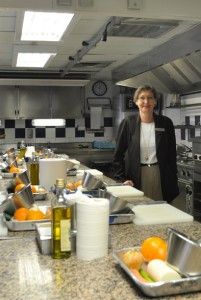
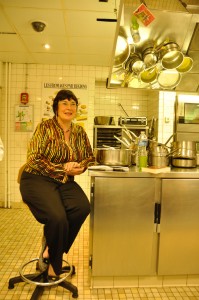 earn my place in his esteemed two and a half hour lecture by delivering my own small speech on the evolution of food culture in Australia in recent times and its historical context from convict days and colonisation.
earn my place in his esteemed two and a half hour lecture by delivering my own small speech on the evolution of food culture in Australia in recent times and its historical context from convict days and colonisation.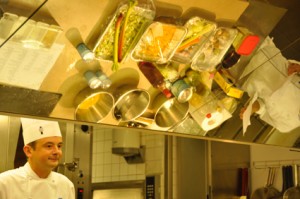 langoustines et arancini (pan-fried sea bream, squid stuffed with langoustine risotto and arancini.) Dessert will be crème citronnelle, agrumes en gelee et rhubarb croustillante (Lemon grass cream, citrus jelly and rhubarb crisps).
langoustines et arancini (pan-fried sea bream, squid stuffed with langoustine risotto and arancini.) Dessert will be crème citronnelle, agrumes en gelee et rhubarb croustillante (Lemon grass cream, citrus jelly and rhubarb crisps).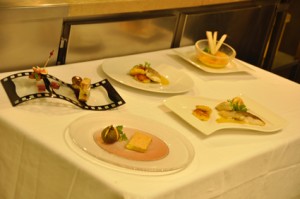 All too soon, chef is presenting his dishes – two different presentations for the fish dish, and two different glass bowls for dessert.
All too soon, chef is presenting his dishes – two different presentations for the fish dish, and two different glass bowls for dessert.